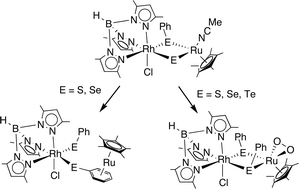Reactions of [Tp*Rh(coe)(MeCN)]
(1; Tp*
= hydrotris(3,5-dimethylpyrazol-1-yl); coe = cyclooctene) with one equiv of diphenyl dichalcogenides PhEEPh (E = Se, Te) afforded the mononuclear RhIII complexes [Tp*Rh(EPh)2(MeCN)]
(2b: E = Se; 2c: E = Te), as reported previously for the formation of [Tp*Rh(SPh)2(MeCN)]
(2a) from the reaction of 1 and PhSSPh. Complexes 2a–2c were treated with the RuII complex [(Cp*Ru)4(µ3-Cl)4]
(Cp*
=
η5-C5Me5) in THF at room temperature, yielding the chalcogenolato-bridged dinuclear complexes [Tp*RhCl(µ-EPh)2RuCp*(MeCN)]
(3). Complex 3a
(E = S) in solution was converted slowly into a mixture of 3a and the sterically less encumbered dinuclear complex [Tp*RhCl(SPh)(µ-η1-S-η6-Ph)RuCp*]
(4a) at room temperature. In 4a, one SPh group binds only to the Rh center as a terminal ligand, while the other SPh group bridges the Rh and Ru atoms by coordinating to the former at the S atom and to the latter with the Ph group in a π fashion. The Se analogue 3b also underwent a similar transformation under more forcing conditions, e.g. in benzene at reflux, whereas formation of the µ–η1-Te-η6-Ph complex was not observed for the Te analogue 3c even under these forcing conditions. When complexes 3 was dissolved in THF exposed to air, the MeCN ligand bound to Ru was substituted by dioxygen to give the peroxo complexes [Tp*RhCl(µ-EPh)2RuCp*(η2-O2)]
(5a: E = S; 5b: E = Se; 5c: E = Te). X-Ray analyses have been undertaken to determine the detailed structures for 2c, 3a, 3b, 4a, 5a, 5b, and 5c.

You have access to this article
 Please wait while we load your content...
Something went wrong. Try again?
Please wait while we load your content...
Something went wrong. Try again?


 Please wait while we load your content...
Please wait while we load your content...